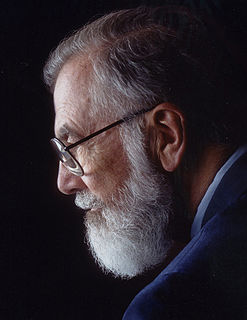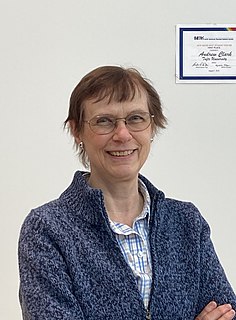Related Research Articles
Ludwik Leibler, born in 1952 is a Polish-born French physicist. He is Professor of École supérieure de physique et de chimie industrielles de la ville de Paris and member of the French Academy of Sciences and National Academy of Engineering.

Alexandra Navrotsky is a physical chemist in the field of nanogeoscience. She is an elected member of the United States National Academy of Sciences (NAS) and the American Philosophical Society (APS). She was a board member of the Earth Sciences and Resources division of the NAS from 1995 until 2000.

Ching Wan Tang is a Hong Kong–American physical chemist. He was inducted into the National Inventors Hall of Fame in 2018 for inventing OLED, and was awarded the 2011 Wolf Prize in Chemistry. Tang is the IAS Bank of East Asia Professor at the Hong Kong University of Science and Technology and previously served as the Doris Johns Cherry Professor at the University of Rochester.
Stephen Z. D. Cheng is a Chinese-American polymer scientist and chemical engineer. Cheng is the R.C.Musson & Trustees Professor of Polymer Science, and was the former Dean of the College of Polymer Science & Polymer Engineering at the University of Akron.

Harvey Douglas Keith was a physicist and one of the primary polymer researchers over the latter half of the 20th century.

Marsha Isack Lester is an American physical chemist. She is currently the Edmund J. Kahn Distinguished Professor of Chemistry at the University of Pennsylvania. Lester uses both theoretical and experimental methods to study the physical chemistry of volatile organic compounds present in the earth's atmosphere. Her current work focuses on the hydroxyl radical and Criegee intermediates.
Timothy P. Lodge is an American polymer scientist.

Elaine Surick Oran is an American physical scientist and is considered a world authority on numerical methods for large-scale simulation of physical systems. She has pioneered computational technology for the solution of complex reactive flow problems, unifying concepts from science, mathematics, engineering and computer science in a new methodology. An incredibly diverse range of phenomena can be modeled and better understood using her techniques for numerical simulation of fluid flows, ranging from the tightly-grouped movements of fish in Earth's oceans to the explosions of far-flung supernovae in space. Her work has contributed significantly to the advancement of the engineering profession.

Eugenia Kumacheva is a University Professor and Distinguished Professor of Chemistry at the University of Toronto. Her research interests span across the fields of fundamental and applied polymers science, nanotechnology, microfluidics, and interface chemistry. She was awarded the L'Oréal-UNESCO Awards for Women in Science in 2008 "for the design and development of new materials with many applications including targeted drug delivery for cancer treatments and materials for high density optical data storage". In 2011, she published a book on the Microfluidic Reactors for Polymer Particles co-authored with Piotr Garstecki. She is Canadian Research Chair in Advanced Polymer Materials. She is Fellow of the Royal Society (FRS) and a Fellow of the Royal Society of Canada (FRSC).

Matthew V. Tirrell is an American chemical engineer. In 2011 he became the Founding Pritzker Director and Dean of the Institute for Molecular Engineering (IME) at the University of Chicago, in addition to serving as senior scientist at Argonne National Laboratory. Tirrell's research specializes in the manipulation and measurement of polymer surface properties, polyelectrolyte complexation, and biomedical nanoparticles.
Mary E. Galvin is an American scientist and the former Dean of the University of Notre Dame College of Science. She earned her BA in chemistry at Manhattanville College and her MSc and PhD degrees in polymers and materials science at the Massachusetts Institute of Technology. Galvin worked at Bell Laboratories following the completion of her doctorate work until 1998, when she joined the faculty at the University of Delaware. In 2005, Galvin entered the private sector as a technical lead in new technology development at Air Products and Chemicals, Inc. In 2013, she became the director of the Materials Science division at the National Science Foundation, and then in 2015 began as the dean of the Notre Dame College of Science.

Albert Stolow is a Canadian physicist. He is the Canada Research Chair in Molecular Photonics, Full Professor of Chemistry & Biomolecular Sciences and of Physics, and a Member of the Ottawa Institute for Systems Biology at the University of Ottawa. He is the founder and an ongoing member of the Molecular Photonics Group at the National Research Council of Canada. He is Adjunct Professor of Chemistry and of Physics at Queen's University in Kingston, and a Graduate Faculty Scholar in the Department of Physics, University of Central Florida and a Fellow of the Max-Planck-uOttawa Centre for Extreme and Quantum Photonics. In 2008, he was elected a Fellow in the American Physical Society, nominated by its Division of Chemical Physics in 2008, for contributions to ultrafast laser science as applied to molecular physics, including time-resolved studies of non-adiabatic dynamics in excited molecules, non-perturbative quantum control of molecular dynamics, and dynamics of polyatomic molecules in strong laser fields. In 2008, Stolow won the Keith Laidler Award of the Canadian Society for Chemistry, for a distinguished contribution to the field of physical chemistry, recognizing early career achievement. In 2009, he was elected a Fellow of the Optical Society of America for the application of ultrafast optical techniques to molecular dynamics and control, in particular, studies of molecules in strong laser fields and the development of new methods of optical quantum control. In 2013, he was awarded the Queen Elizabeth II Diamond Jubilee Medal (Canada). In 2017, Stolow was awarded the Earle K. Plyler Prize for Molecular Spectroscopy and Dynamics of the American Physical Society for the development of methods for probing and controlling ultrafast dynamics in polyatomic molecules, including time-resolved photoelectron spectroscopy and imaging, strong field molecular ionization, and dynamic Stark quantum control. In 2018, Stolow was awarded the John C. Polanyi Award of the Canadian Society for Chemistry “for excellence by a scientist carrying out research in Canada in physical, theoretical or computational chemistry or chemical physics”. In 2020, he became Chair of the Division of Chemical Physics of the American Physical Society. His group's research interests include ultrafast molecular dynamics and quantum control, time-resolved photoelectron spectroscopy and imaging, strong field & attosecond physics of polyatomic molecules, and coherent non-linear optical microscopy of live cells/tissues, materials and geological samples. In 2020, Stolow launched a major new high power ultrafast laser facility at the University of Ottawa producing high energy, phase-controlled few-cycle pulses of 2 micron wavelength at 10 kHz repetition rate. These are used for High Harmonic Generation to produce bright ultrafast Soft X-ray pulses for a new Ultrafast Xray Science Laboratory.
Anna Christina Balazs is an American materials scientist and engineer. She currently is Distinguished Professor at the University of Pittsburgh and holds the John A. Swanson Chair at the Swanson School of Engineering.
Katherine Birgitta Whaley is a Professor of Chemistry at the University of California Berkeley and a senior faculty scientist in the Division of Chemical Sciences at Lawrence Berkeley National Laboratory. At UC Berkeley, Whaley is the Director of the Berkeley Quantum Information and Computation Center, a member of the executive board for the Center for Quantum Coherent Science, and a member of the Kavli Energy Nanosciences Institute. At Lawrence Berkeley National Laboratory, Whaley is a member of the Quantum Algorithms Team for Chemical Sciences in the research area of resource-efficient algorithms.
Zahra Fakhraai is an Iranian-Canadian materials scientist who is a Professor of Chemistry at the University of Pennsylvania. Fakhraai does research focused on glass transition, nonlinear optics, nanoparticle plasmonics, and polymer physics. She studies the impact of nanoconfinement on the structure of materials. She was awarded the 2019 American Physical Society John H. Dillon Medal. Fakhraai was one of the researchers to start laying the ground work to better understand the optical properties of glass.

Peggy Cebe is a professor of physics in the Department of Physics and Astronomy of Tufts University.

Susan Buthaina Sinnott is professor and head of materials science and engineering at Pennsylvania State University. Sinnott is a fellow of the Materials Research Society (MRS), the American Association for the Advancement of Science (AAAS) and the American Physical Society (APS). She has served as editor-in-chief of the journal Computational Materials Science since 2014.
Julia A. Kornfield is a Professor of Chemical Engineering at the California Institute of Technology. Her research considers the development of mega-supramolecular systems for fuel additives and intraocular lenses.
Sandra Marina Troian is an American applied physicist known for her research on fluid dynamics, quasicrystals, surface science, thin films, microfluidics, and spacecraft micropropulsion. She is a professor of Applied Physics, Aeronautics, and Mechanical Engineering in the Division of Engineering and Applied Science of the California Institute of Technology (Caltech), and head of the Laboratory of Interfacial and Small Scale Transport in the Department of Applied Physics and Materials Science at Caltech.
Marina Guenza is an Italian theoretical physical chemist who studies the fluid dynamics of macromolecules. She is a professor of chemistry and biochemistry at the University of Oregon.
References
- ↑ University of Toronto President's Report for the year ended June 1957, University of Toronto Press, 1958, p. 124
- ↑ Author affiliation as listed in Petrie, S. E.; McIntosh, R.; Channen, E. W. (December 1957), "The temperature dependence of apparent dielectric constants of adsorbates on non-porous titanium dioxide", Canadian Journal of Chemistry, Canadian Science Publishing, 35 (12): 1534–1541, doi:10.1139/v57-201
- ↑ "BusinessPeople", Democrat and Chronicle, p. 36, 5 August 1977 – via Newspapers.com
- ↑ "Officers 1951-2001 and Councilors", History update 1991–2001, American Chemical Society Division of Polymer Chemistry, retrieved 2022-01-03
- ↑ Polymer Science and Engineering: The Shifting Research Frontiers, National Academy Press, 1994
- ↑ "Fellows nominated in 1976 by the Division of Polymer Physics", APS Fellows archive, American Physical Society, retrieved 2022-01-03